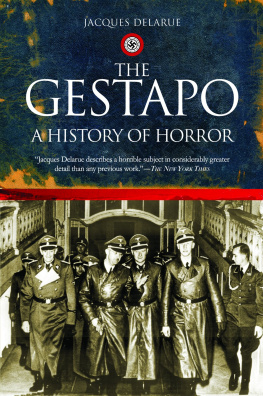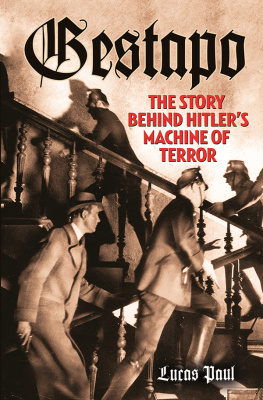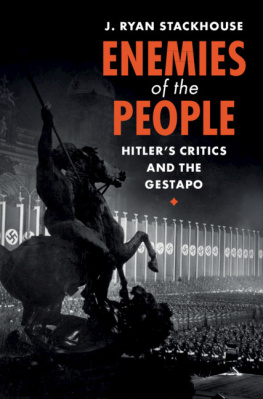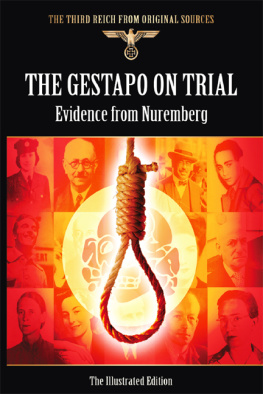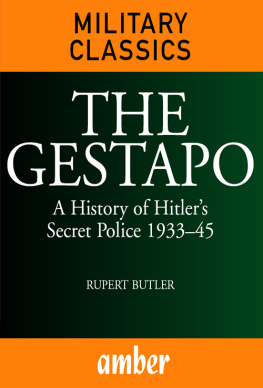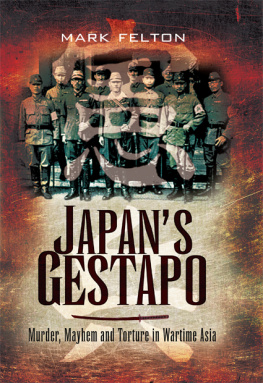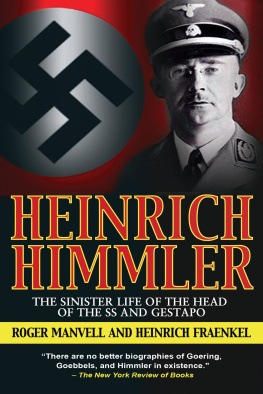I. THE INTERNAL STRUCTURE OF THE R.S.H.A.
From its creation, the R.S.H.A. was divided into seven Amter.
Amt I Streckenbach from July 1940 to the beginning of 1943; Schulz from the beginning of 1943 to November 1943; Ehrlinger from November 1943 to the capitulation.
Amt II: Administrative and economic questions . Divided into four groups:
II A: Premises, upkeep, pay, accountancy questions.
II B: Economic questions, relations with the Ministry of Justice, prisoners (with the exception of the prisons and the camps), transport of prisoners.
II C: Material administration of the active services, SIPO-S.D.
II D: Technical group (in particular car service). Successive leaders, Dr. Best from creation to July 1940, Nockemann, Siegert, Spacil.
Amt III: Internal S.D., Party organization . Active intelligence service divided into five groups. Its main strength comprised three to four hundred agents.
III A: Questions concerning law and the structure of the Reich. (Subgroup III A-4 compiled regular reports on public opinion and the attitude of the population.)
III B: Problems relating to the ethnic community of the Reich. Ethnic minorities, race, and public health.
III C: Cultural matters, science, education, the arts, and the press. Intelligence in religious circles.
III D: Economic questions, surveillance of industry and the industrialists, supplies, labor, commerce, etc. Group G: brief honorary agentshigh society espionage.
Leaders: S.S. Gruppenfuehrer Otto Ohlendorf from the beginning to the end.
Amt IV: Gestapo, State organization . Active service invested with executive powers (right of arrest) in political matters. Its head office employed fifteen hundred agents. Operational duties: The search for opponents of the regime and repression. Comprised six groups:
IV A: Opponents of National Socialism: Marxists, Communists, reactionaries, and liberals. Countersabotage and general security measures. Group IV A comprised as many as six subgroups.
IV B: Political activity of the Catholic and Protestant churches, religious sects, Jews, Freemasons. Was divided into five subgroups. (Subgroup IV B-4, entrusted with the final solution of the Jewish problem, was directed by Adolf Eichmann.)
IV C: Preventive detention, protective custody. Press. The affairs of the Party, compilating of dossiers, card index.
IV D: Territories occupied by Germany. Foreign workers in Germany.
The subgroup IV D-4 was in charge of the Western territoriesHolland, Belgium, and France. Its leader, Karl Heinz Hoffmann, compiled the order Nacht und Nebel (Night and Fog), which resulted in the disappearance of thousands of deportees.
IV E: Counterespionage (C-E) Six groups: IV E-1: General problems of counterespionage. Counterespionage in the factories of the Reich. IV E-2: General economic problems. IV E-3; Countries of the West. IV E-4: Scandinavian countries. IV E-5: Countries of the East. IV E-6: Countries of the South.
IV F: Frontier Police. Passports, identity cards. Foreign police forces.
From 1941 the head of Amt IV disposed of an additional independent group, Referat N, which supervised the centralization of intelligence.
Leader: Heinrich Mueller from the beginning to the end.
Amt V: KRIPO, State organization . Active service with executive power in criminal matters. Its head office employed 1,200 agents. Divided into four groups:
V A: Criminal police and preventive measures.
V B: Repressive criminal police. Crimes and misdemeanors.
V C: Identification and searches.
V D: Technical criminal institute of the SIPO (Gestapo & KRIPO).
Successive leaders: Artur Nebe, until July 20, 1944. Panzinger from this date until the end.
Amt VI: External S.D. ( S.D.-Ausland ). Party organization. Intelligence abroad. Its head office employed between 300 and 500 agents according to the periods. Divided into six groups and subsequently into eight in the following years.
VI A: General organization of the intelligence services. Control of the activities of the S.D. Sections.
VI B: Direction of espionage activities in western Europe. Three subgroups: VI B-1: France; VI B-2: Spain and Portugal; VI B-3: North Africa.
VI C: Espionage in the zone of Russian influence. Comprised a subgroup VI C-13: Arab section, and the Sonderreferat, VI C-Z (special section) for committing sabotage in the U.S.S.R .
VI D: Espionage in the American zone of influence.
VI E: Espionage in eastern Europe.
VI F: The necessary technical means as a whole of Amt VI.
Amt VI exploited a great number of societies abroad and briefed several thousand agents. One of the most famous was Eliazar Bazna, known as Cicero, briefed in Ankara by S.S. Sturmbannfuehrer Moyzisch, placed in Ankara by Schellenberg.
Successive leaders: Heinz Jost until the beginning of 1941. In 1942 Schellenberg created Group VI G to exploit all scientific intelligence and Group S for the preparation and execution of material, moral, and political sabotage, which was entrusted to Otto Skorzeny.
Amt VII: Written documentation. Ideological research into the opponents of the regime: Freemasonry, Jewry, the churches, liberals, Marxists. Party organization composed of members of the S.D.
Three groups:
VII A: Research and centralization of documentation.
VII B: Exploitation of the documentation. Establishment of syntheses. Biographical notes. Written commentaries, etc.
VII C: Centralization of the records. The perfecting of methods of classification, exploitation, and filing systems. Upkeep of museum, library, photo records, for the whole of the R.S.H.A.
II. THE SECOND OBERG-BOUSQUET AGREEMENT
OBJECT: The communal work of the German and French police forces in newly occupied territory.
At a joint meeting (April 16, 1943) of the chief of the Security Police (SIPO-S.D.), the command, and the regional prefects of the newly occupied territories, I revealed the following rules after an agreement with the general secretary of the French police, Bousquet, for the communal work of the German and French police forces in the newly occupied territories.
1. The German and French police forces are warned that their common task is to maintain law and order efficiently in the field of operations of the German Army in the newly occupied territories; to combat preventively and to preserve with all the means at their disposal the security of the German Army and the interests of the German Reich; also the pacific collaboration of the French people against the attacks of Communists, terrorists, enemy agents, and saboteurs, as well as those who incite themJews, Bolsheviks, and Anglo-Americans. To this end they will collaborate very closely and continuously. The French police in this domain will combat these adversaries on its own responsibility and will at the same time assist the services of the Hoehere S.S. and Polizeifuehrer by transmitting to them immediately all useful information, and by helping them in every other respect. The German police authorities will, for their part, keep the French police informed, passing on the information given the informers, which might be important in taking police measures.
2. The Hoehere S.S. and Polizeifuehrer will notify as far as possible in advance the general secretary of the French police of all the principal measures taken by the German police affecting the common task.
3. All joint police measures which may prove necessary in the interests of the security of the German troops will in principle be ordered and carried out by the local French authorities on their own responsibility. The Hoehere S.S. and Polizeifuehrer will transmit to the general secretary of the French police the corresponding German wishes.

